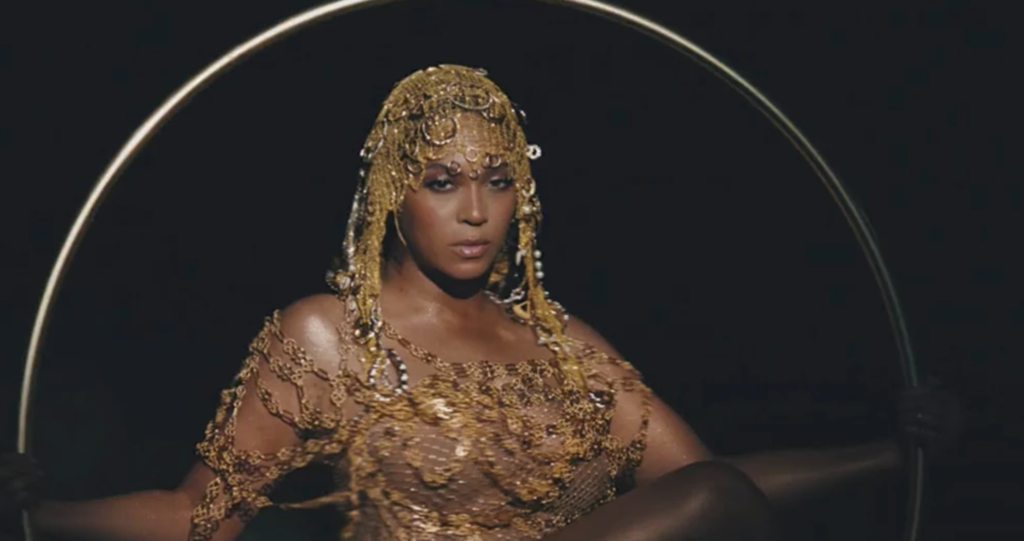
Beyoncé in her new visual album “Black Is King.” Image via Disney+
Beyoncé’s visual album “Black Is King,” released Friday (July 31) on Disney+, brings to life the music of her 2019 album, “The Lion King: The Gift.”
“Black Is King” reimagines the story of “The Lion King,” which told the tale of a young lion named Simba who flees his home after his father, the king, is killed, rediscovering himself and returning years later.
African Americans have been on a similar journey, said writer and theologian Candice Marie Benbow.
“It is this human story of both Simba and Black people — that we are trying to find home, come back to home and live into who we truly and fully are,” said Benbow, who created the #LemonadeSyllabus social media campaign after the release of Beyoncé’s previous visual album, “Lemonade.”
Spirituality plays a huge role in that journey in “Black Is King,” which draws imagery from Christianity and traditional African religions.
“It is this honoring that Black people have always been a spiritual people, full stop, and that spirituality is robust and that to demonize it in any way, shape or form is also to demonize yourself,” Benbow said.
Here are five times religion and spirituality make appearances in “Black Is King.”
1. Moses imagery
“Black Is King” may be a reimagining of “The Lion King,” but the young king’s journey of knowing and returning home to himself and his people also parallels the story of Moses told in the Hebrew Bible, said Tamisha A. Tyler, co-executive director of Art Religion Culture, or ARC, and a doctoral candidate studying theology, culture and ethics.
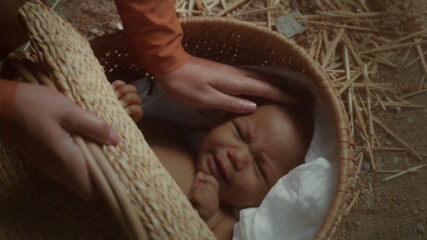
Moses imagery in “Black Is King.” Image via Disney+
At the time Moses was born in Egypt, Pharaoh had enslaved the Israelites and ordered all Hebrew boys who were born to be killed, according to the Book of Exodus. To save her son, Moses’ mother, Jochebed, placed him in a papyrus basket and placed it in the Nile River.
Pharaoh’s daughter discovered Moses and raised him. He went on to lead his people out of slavery in Egypt and is revered as a prophet in a number of religious traditions.
“Moses grew up to be a young man that helped his people find freedom. Moses became then the person or the symbol of liberation” for the people of Israel, Tyler said.
“Black Is King” begins with the image of a basket tumbling down a river.
Later, during the song “Otherside,” viewers see Beyoncé placing her baby into the basket as she sings, “Best believe me / You will see me / On the other side.”
“Moses has always loomed large among African-Americans seeking freedom,” critic Salamishah Tillet wrote in The New York Times.
Nicholas R. Jones, assistant professor of Spanish and Africana studies at Bucknell University, sees the Moses imagery in “Black Is King” as “this rooting and reclaiming of Christianity as a continental African type of religion in many ways.”
After all, Jones pointed out, Christianity was in Africa long before European missionaries and colonizers arrived on the continent.
2. The orishas
“The orishas hold your hand through this journey that began before you were born,” Beyoncé says as the film draws to a close. “We never forget to say thank you to the ancestors, noble and royal, anointed, our blessings in the stars.”
Orishas are “intermediaries between human beings and the higher divine” that are represented or manifested in nature, according to Yoruba spirituality, Jones said.
Beyoncé first appears in the film on the beach, dressed in white and holding the baby she presumedly has drawn from the water. She kneels in front of two men swinging censers as she describes “coils in hair catching centuries of prayers spread through smoke.”
“You are welcome to come home to yourself. Let ‘Black’ be synonymous with glory,” she says.
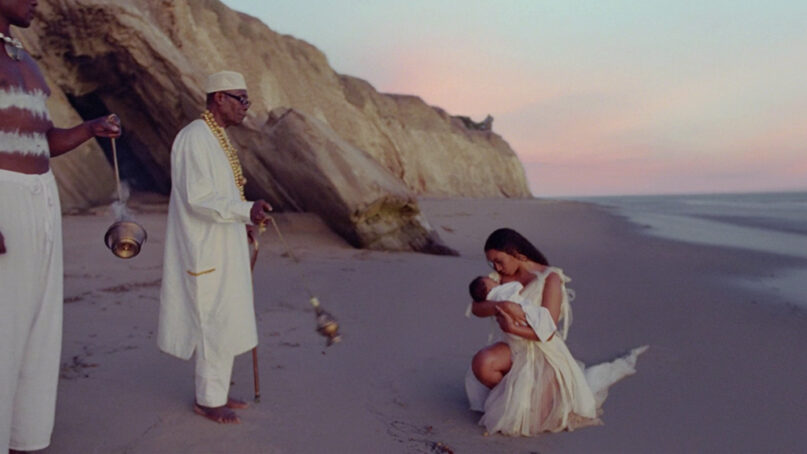
Beyoncé carries a child in the beginning of her new visual album, “Black Is King.” Image via Disney+
Jones and Benbow describe the scene as an offering to Olokun, the orisha who has dominion over the ocean, depths, darkness and profundity.
“You are immediately tuned into the fact that this is a deeply spiritual quest, and it begins with an offering to the African deities who have carried our ancestors and who carry us,” Benbow said.
Beyoncé also is channeling Oya, an orisha often represented by the water buffalo, when she appears wearing horns and cowhide and smoking a pipe in another scene, Jones said.
There are other spiritual beings in the film, too, including the zangbeto — shown covered in palm fronds and climbing onto the hood of the adult king’s car later in the film — who “puts things back in order and essentially demands justice,” he said.
“For me, in ‘Black Is King,’ Beyoncé is really playing with all of these types of images, iconography, so on and so forth,” Jones said.
“I really see the message being a decolonial type of spiritual project, really calling both Black people in the diaspora and in continental Africa, as well, to sort of this decolonial project to return to your roots — explore your ancestral, spiritual, religious roots.”
3. The divine feminine
Throughout the film, Beyoncé embodies the divine feminine, imagery she has evoked many times before.
Viewers of her 2017 Grammys performance spotted references to Kali, a Hindu goddess who has been worshipped as the Divine Mother and Mother of the Universe; Venus, the Roman goddess of love and beauty; and the Virgin Mary, the mother of Jesus in Christian traditions. Beyoncé also evoked images of two orishas: Yemoja and Oshun.
“Black Is King” offers glimpses of paintings in the background of several scenes in which Beyoncé is depicted as the Virgin Mary, haloed and holding a child.
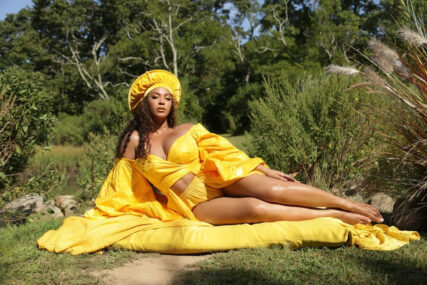
Beyoncé depicted as Oshun in her new visual album, “Black Is King.” Image via Disney+
Perhaps most notably, she embodies Oshun, the orisha associated with fertility, love and beauty.
She makes this clear in the song “Mood 4 Eva,” singing, “I am Beyoncé Giselle Knowles-Carter / I am the Nala, sister of Naruba / Oshun, Queen Sheba, I am the mother.”
Like Oshun, Beyoncé is pictured in gold and yellow and often near water and waterfalls. She also is accompanied — as are several of Oshun’s avatars — by birds, including peacocks and vultures, according to Jones.
“Even in the diaspora, when enslaved Africans were clearly praying to Virgin Mary, we have to think about different forms of religious syncretism and the camouflaging of Catholic saints with different orishas or divinity,” he said.
4. Water
Beyoncé returns to water again and again in “Black Is King.”
“Water” is the name of one of the songs in the visual album, featuring Pharrell Williams and Salatiel. The film features rivers, waterfalls, the ocean, recycled water containers, even a synchronized swimming sequence, and serves as the setting for rituals and offerings.
“Water signifies life. Water signifies purity. Water signifies hope and water signifies the ability to be reborn,” says a voiceover in the film.
Water is a symbol of rebirth in the Christian rite of baptism, Benbow said. It represents life, she said, pointing out many believe the continent of Africa is the origin of all life and civilization.
“And so to go back to water, which represents life, and to see these Black people in water, dancing in water, doing all of this around water, it is again embracing the truth that this life, these contributions, what we know to be true, to be us, they don’t exist without Black people,” she said.
Water also is part of the imagery associated with several orishas, including Olokun, Yemoja and Oshun.
In “Black Is King” water is “transformative,” Cate Young wrote for NPR.
“Its mythical power is reflected in both the pain of sailing Black people across endless oceans for subjugation and its healing potential to wash away the violence of that history,” Young said.
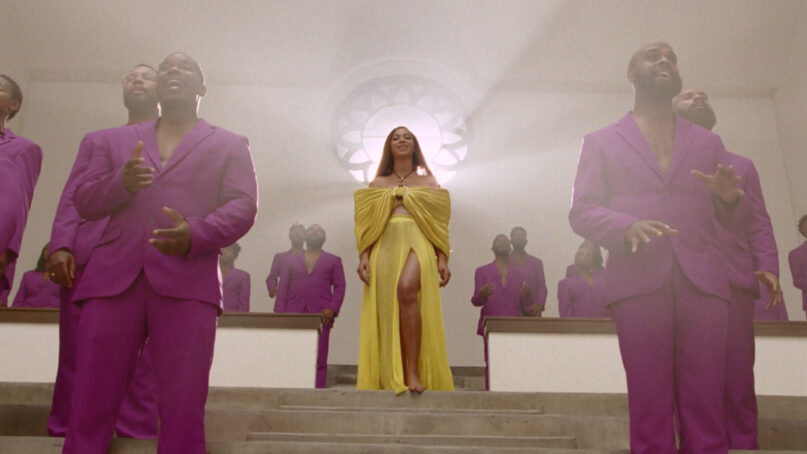
Beyoncé performs ’Spirit’ in her new visual album, “Black Is King.” Image via Disney+
5. Coming full circle
One of the film’s most powerful moments comes near the end, when Beyoncé sings the triumphant anthem “Spirit” in what appears to be a sun-drenched chapel. She is framed in the window like a halo and surrounded by a choir dressed in purple.
Tyler sees the scene coming full circle from the opening Moses sequence.
“You can’t get that moment in ‘Spirit’ without seeing all of the orishas. All these different pieces that you see throughout the film lead up to ‘Spirit,’” she said.
“It’s a return to something that you understand at a deeper level now, so that the choir, the voices singing together, that moment in that church is deeper because you’ve reclaimed a part of yourself that people have tried to deny you.”
Even as she appears surrounded by the church choir, Beyoncé is dressed in yellow, evoking Oshun.
The moment highlights the way the spirit that has guided and continues to guide Black people is “at work in all places,” Benbow said.
“Beyoncé is a church girl, born and raised Methodist. She just released another visual album steeped in honor and reverence of the indigenous religious/spiritual practices of our ancestors,” she tweeted.
“Sis, if you have been looking for permission to explore and understand, let this be it.”
